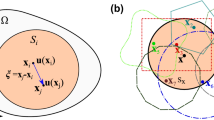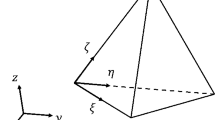Abstract
A new element is developed by introducing a nonlocal-integrated displacement interpolation into the ‘FE-Meshfree’ QUAD4 element recently published. Both nodal displacement and elemental strain are constructed using the nonlocal concept so that the elemental stiffness matrix and the resulting deformation fields are naturally nonlocal, leading to a significant difference when compared with nonlocal simulations using existing finite elements where local fields are output firstly in each incremental step and their nonlocal counterparts are obtained by averaging. The proposed element has the capability of predicting the nonlocal characteristics of localized deformations, with the intrinsic material length included into the nonlocal averaging. Several examples are employed to demonstrate the advantage of the proposed element in capturing highly localized deformations.


















Similar content being viewed by others
References
Belytschko T, Lu YY, Gu L (1994) Element free Galerkin methods. Int J Numer Methods Eng 37:229–256
Liu WK, Jun S, Zhang YF (1995) Reproducing kernel particle methods. Int J Numer Methods Fluids 20:1081–1106
Atluri SN, Zhu T (1998) A new meshless local Petrov-Galerkin (MLPG) approach in computational mechanics. Comput Mech 22:117–127
Liu GR, Gu YT (2001) A point interpolation method for two dimensional solid. Int J Numer Methods Eng 50:937–951
Liu GR, Gu YT (2001) A local point interpolation method for stress analysis of two-dimensional solids. Struct Eng Mech 11:221–236
Idelsohn SR, Onate E (2006) To mesh or not to mesh. That is the question. Comput Methods Appl Mech Eng 195:4681–4696
Hao S, Liu WK (2006) Moving particle finite element method with superconvergence: nodal integration formulation and applications. Comput Methods Appl Mech Eng 195:6059–6072
Liu GR, Gu YT (2000) Meshless local Petrov-Galerkin (MLPG) method in combination with finite element and boundary element approaches. Comput Mech 26:536–546
Melenk JM, Babuska I (1996) The partition of unity finite element method: basic theory and applications. Comput Methods Appl Mech Eng 139:289–314
Oden JT, Duarte CA, Zienkiewicz OC (1998) A new cloud-based hp finite element method. Comput Methods Appl Mech Eng 153: 117–126
Babuska I, Melenk JM (1997) Partition of unity method. Int J Numer Methods Eng 40:727–758
Liu WK, Han W, Lu H, Li S, Cao J (2004) Reproducing kernel element method. Part I: theoretical formulation. Comput Methods Appl Mech Eng 193:933–951
Li S, Lu H, Han W, Liu WK, Simkins DC Jr (2004) Reproducing kernel element method Part II: globally conforming I\(^{{\rm m}}\)/C\(^{{\rm n}}\) hierarchies. Comput Methods Appl Mech Eng 193:953–987
Lu H, Li S, Simkins DC Jr, Liu WK, Cao J (2004) Reproducing kernel element method Part III: generalized enrichment and applications. Comput Methods Appl Mech Eng 193:989–1011
Simkins DC Jr, Li S, Lu H, Liu WK (2004) Reproducing kernel element method. Part IV: globally compatible C\(^{{\rm n}}\) (n> = 1) triangular hierarchy. Comput Methods Appl Mech Eng 193:1013–1034
Lu H, Kim DW, Liu WK (2005) Treatment of discontinuity in the reproducing kernel element method. Int J Numer Methods Eng 63:241–255
Rajendran S, Liew KM (2003) A novel unsymmetric 8-node plane element immune to mesh distortion under a quadratic displacement field. Int J Numer Methods Eng 58:1713–1748
Ooi ET, Rajendran S, Yeo JH, Zhang BR (2007) A mesh distortion tolerant 8-node solid element based on the partition of unity method with inter-element compatibility and completeness properties. Finite Elem Anal Des 43:771–787
Rajendran S, Zhang BR (2007) A “FE-meshfree” QUAD4 element based on partition of unity. Comput Methods Appl Mech Eng 197:128–147
Rajendran S, Zhang BR, Liew KM (2009) A partition of unity-based ’FE-Meshfree’ QUAD4 element for geometric non-linear analysis. Comput Methods Appl Mech Eng 82:1574–1608
Xu JP, Rajendran S (2011) A ’FE-Meshfree’ QUAD4 element with radial-polynomial basis function for static analyses. Comput Methods Appl Mech Eng 200:3309–3323
Xu JP, Rajendran S (2013) A ’FE-Meshfree’ TRIA3 element based on partition of unity for linear and geometry nonlinear analyses. Comput Mech 51:843–864
Bažant ZP, Oh BH (1983) Crack band theory for fracture of concrete. Mater Struct 16(3):155–177
Chen JS, Wu CT, Belytschko T (2000) Regularization of material instabilities by meshfree approximations with intrinsic length scales. Int J Numer Methods Eng 47:1303–1322
Chen JS, Zhang X, Belytschko T (2004) An implicit gradient model by a reproducing kernel strain regularization in strain localization problems. Comput Methods Appl Mech Eng 193(27):2827–2844
Wang D, Li Z (2013) A two-level strain smoothing regularized meshfree approach with stabilized conforming nodal integration for elastic damage analysis. Int J Damage Mech 22:440–459
Wang D, Li L, Li Z (2014) A regularized Lagrangian meshfree method for rainfall infiltration triggered slope failure analysis. Eng Anal Bound Elem 42:51–59
Stromberg L, Ristinmaa M (1996) FE-formulation of a nonlocal plasticity thoery. Comput Methods Appl Mech Eng 136:127–144
Anand L, Aslan O, Chester SA (2012) A large-deformation gradient theory for elastic-plastic materials: Strain softening and regularization of shear band. Int J Plast 30–31:116–143
Liu GR, Gu YT (2001) A local radial point interpolation method (LR-PIM) for free vibration analyses for 2-D solids. J Sound Vib 246:29–46
Reddy J (2004) An introduction to nonlinear finite element analysis. Oxford University Press Inc., New York
Acknowledgments
The third author (S. Rajendran) thanks the support provided by research Grant No. RG 29/08 (M52050104) of Academic Research Fund (AcRF) Tier 1, Ministry of Education, Singapore for carrying out this research. The work of J.X. Liu was supported by the Jiangsu University and Jiangsu Provincial Specially-Appointed Professor grants, Jiangsu Science Fund for Youth no. BK20140520, and Jiangsu Provincial ‘Shuang-Chuang’ grant.
Author information
Authors and Affiliations
Corresponding author
Additional information
Jiangping Xu and Jinxing Liu contributed equally to this work and should be considered to be co-first authors.
Appendices
Appendix A: Approximation of influence region
In Eq. 18, an approximation has been made. As shown in Fig. 2, when we calculate the displacement at point \(\left( x,y\right) \) via the integration in Eq. 18, the integration region is made up of all elements falling into the red circle centered by the center of the element that the point \(\left( x,y\right) \) lies in. When the contribution of the integration point \(\left( \xi ,\eta \right) \) is considered, in principle the displacement vector \(\underset{L\,\times \,1}{\varvec{u}}\left( \xi ,\eta \right) \) is composed of the displacement of each node falling into the blue circle corresponding to the element that the point \(\left( \xi ,\eta \right) \) lies in, as shown in Eq. 14. Since the blue circle and the red circle generally do not overlap, displacements of nodes within the blue circle but outside the red also have influence. However, we argue that nodal displacements outside the red circle are neglect-able when calculating the elemental displacement field of the element at the center of the red circle, as long as the radius of the red circle is chosen to be large enough compared with the the characteristic length. This is easy to understand because of the fast decay of the exponential function in Eq. 18.
Under this approximation, we explain the construction of \(\underset{1\,\times \, L}{\varvec{\hat{\varPsi }}}\) in Eq. 18. Still take Fig. 2 as an example. In the influence region for point \(\left( x,y\right) \), denoted as \(\varOmega \left( x,y\right) \), there are 52 nodes which are numbered in the figure, say \(\alpha =1,2,\ldots ,52\). In the influence region for point \(\left( \xi ,\eta \right) \), say \(\varOmega \left( \xi ,\eta \right) \), some nodes fall into \(\varOmega \left( x,y\right) \), while others do not. Only nodes lying in the common part of \(\varOmega \left( x,y\right) \) and \(\varOmega \left( \xi ,\eta \right) \) are accounted in Eq. 18. Therefore, each of those common nodes is numbered differently in two regions, and we define a number mapping for common nodes as follows
Then \(\underset{1\,\times \, L}{\varvec{\hat{\varPsi }}}\left( \xi ,\eta \right) \) in Eq. 18 can be expressed in the form
where,
Analogously, \(\underset{1\,\times \, L}{\varvec{\hat{\varPsi }_{,x}}}\) in Eq. 21 and \(\underset{1\,\times \, L}{\varvec{\hat{\varPsi }_{,y}}}\) in Eq. 22 are obtained as
where,
Appendix B: Challenge in calculating derivatives of Eq. 18
To obtain the stains, one may be curious why we do not directly calculate derivatives of Eq. 18 instead of using Eqs. 20–25. This is explained as follows.
Operation \(\frac{\partial }{\partial x}\) on both sides of Eq. 18 gives
where,
From Eqs. 61 and 62, the contributions from integration points with \(\xi =x\) are zero. But this is unrealistic. As an example, according to Eq. 59, the point \(\left( x,y\right) \) itself has no contribution to the derivative at the same point, which is unreasonable.
Rights and permissions
About this article
Cite this article
Xu, J., Liu, J. & Rajendran, S. A hybrid ‘FE-Meshfree’ QUAD4 element with nonlocal features. Comput Mech 56, 317–329 (2015). https://doi.org/10.1007/s00466-015-1173-y
Received:
Accepted:
Published:
Issue Date:
DOI: https://doi.org/10.1007/s00466-015-1173-y




